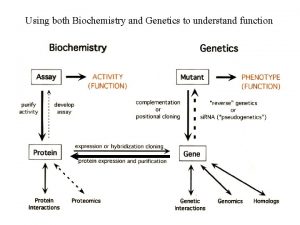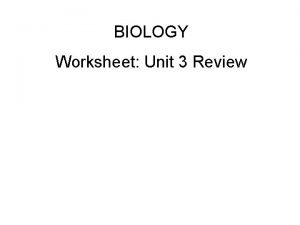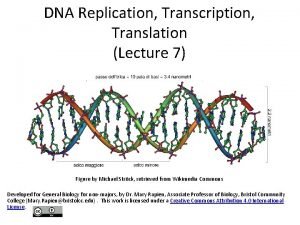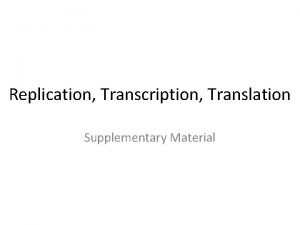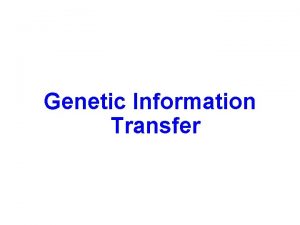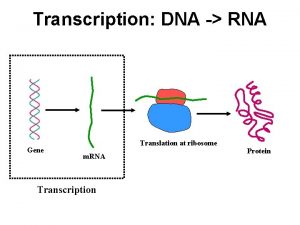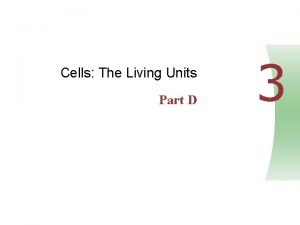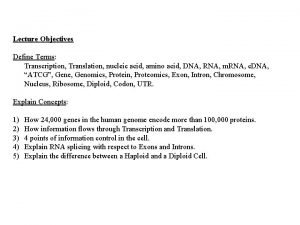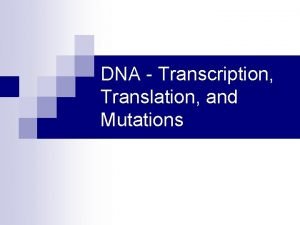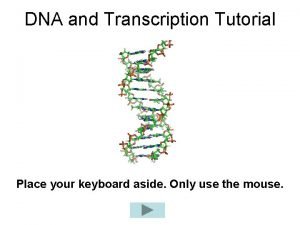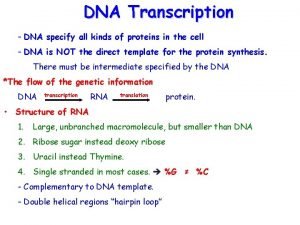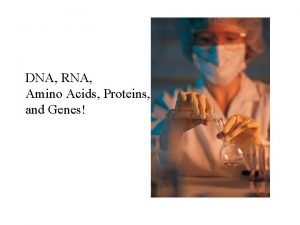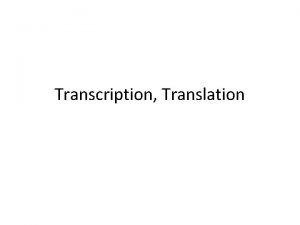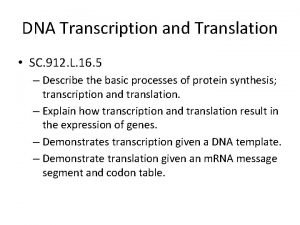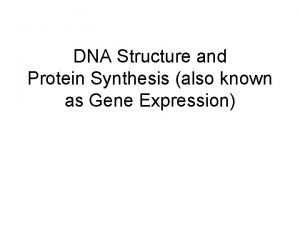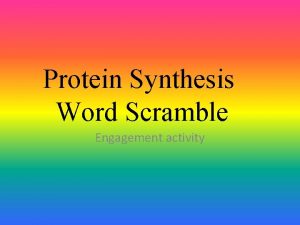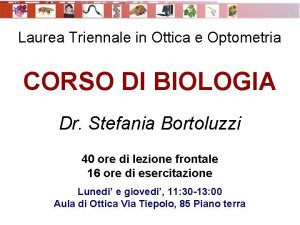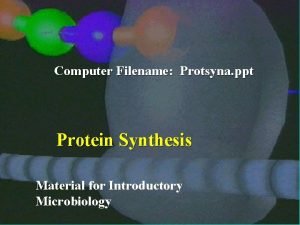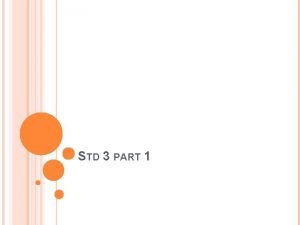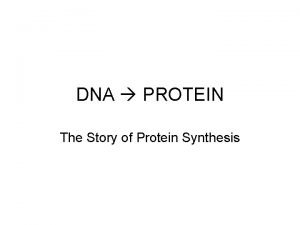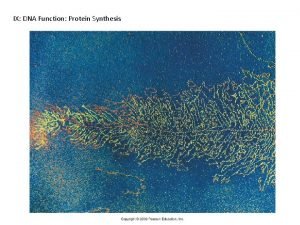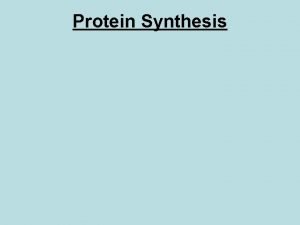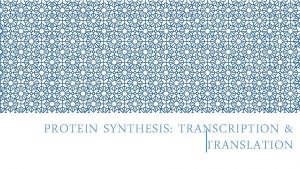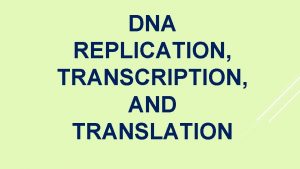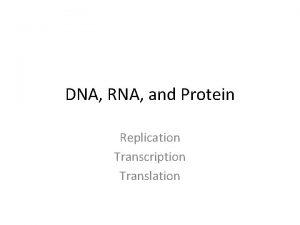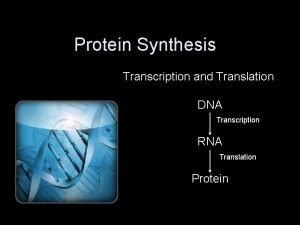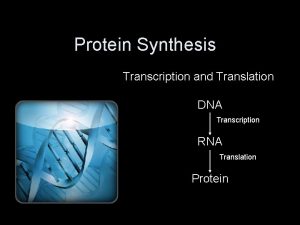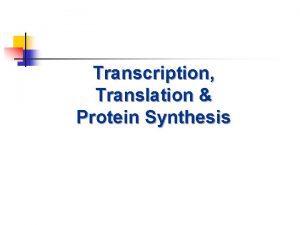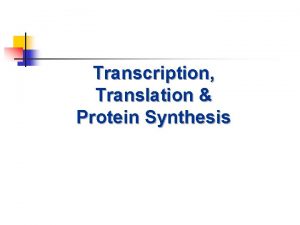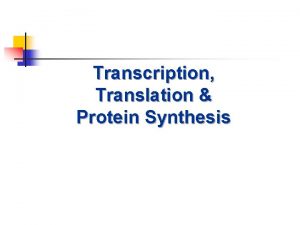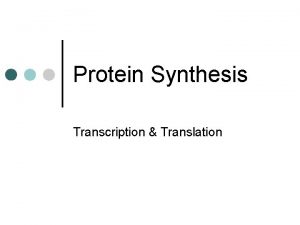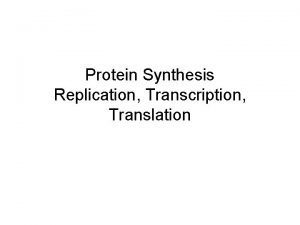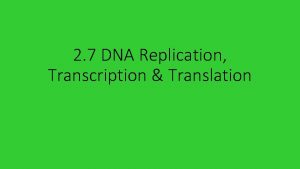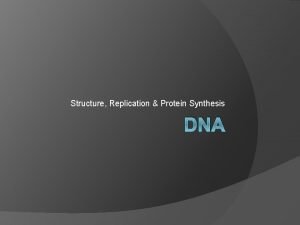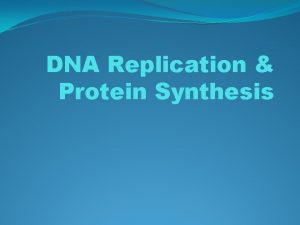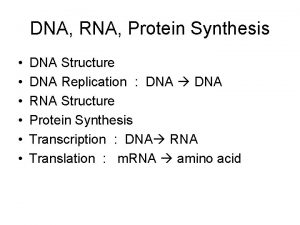DNA PROCESSES DNA replication Protein Synthesis DNA transcription





































- Slides: 37

DNA PROCESSES DNA replication Protein Synthesis: DNA transcription and translation Mizzz Foster © 2019

DNA Processes �There are three DNA processes vital for life. �DNA replication: DNA makes a copy of itself with the help of enzymes. �DNA Transcription: DNA is transcribed into RNA with the help of enzymes. �DNA Translation: The RNA is translated into amino acids which become a polypeptide chain to be folded into a protein. Mizzz Foster © 2019

Important Vocabulary Terms � DNA: sequence of DNA nucleotides which carry genetic information. � RNA: sequence of RNA nucleotides transcribed from DNA. � m. RNA: messenger RNA, carrying the genetic information from DNA to the ribosome. � t. RNA: transfer RNA, molecule which carries the appropriate amino acid over to the ribosome. � r. RNA: ribosomal RNA, which is found embedded in the ribosomes. Mizzz Foster © 2019

Important Vocabulary Terms � Enzyme: Specialized protein used to either build or break down biomolecule polymers. � Polymerase: Specialized enzyme which builds polymers from monomers using dehydration synthesis. � Codon: Three nucleotides which code for a specific amino acid. � Anticodon: Compliments the codon and is carried by the t. RNA. � Amino Acid: monomer of proteins. � Polypeptide chain: Long chain of amino acids bonded together which will be folded into a functional protein. Mizzz Foster © 2019

DNA Replication �DNA replication is the basis for biological inheritance which is a fundamental process that occurs in all living organisms which copies the DNA for each cell in order to produce offspring. Mizzz Foster © 2019

DNA Replication � IN the process of DNA replication each strand of the original double stranded DNA molecule serves as a template (pattern) for the reproduction of the new complimentary DNA strand. � Following replication, two identical DNA molecules have been produced from a single double stranded DNA molecule. Mizzz Foster © 2019

Mizzz Foster © 2019

DNA Replication �DNA replication takes placing during the S phase of the cell cycle. �DNA replication takes place inside the nucleus. Mizzz Foster © 2019

DNA replication The original template DNA is strand blue. The newly synthesizing DNA is strand red. Mizzz Foster © 2019

DNA Replication Example � DNA template: TTA GCG GTA ATC CAT AAG CGT � becomes � NEW . . . DNA: �T pairs with A �G pairs with C Mizzz Foster © 2019

DNA Replication Example � DNA template: TTA GCG GTA ATC CAT AAG CGT � becomes � NEW . . . DNA: AAT CGC CAT TAG GTA TTC GCA �T pairs with A �G pairs with C Mizzz Foster © 2019

DNA Replication � 1. Helicase – Enzyme which unwinds the DNA molecule. � 2. Single Strand binding protein – Enzymes which hold the DNA strands open and apart to prevent rebinding and rewinding of the DNA helix. Mizzz Foster © 2019

DNA replication � 3. Primase – Enzyme which adds RNA nucleotides to help the DNA Polymerase III attach to the DNA templates. � (Complimentary RNA nucleotides are added to the template DNA because DNA polymerase III must add the new DNA nucleotides to an existing strand of nucleotides. ) Mizzz Foster © 2019

DNA Replication � 4. DNA Polymerase III – Enzyme which attaches to the RNA nucleotides then precedes to read DNA in the 3’ to 5’ direction and adds the corresponding DNA nucleotides. Mizzz Foster © 2019

DNA Replication � 5. DNA polymerase I – Enzyme which reads over the newly synthesized DNA looking for mistakes and left over RNA nucleotides. The mistakes and RNA nucleotides are removed and replaced with DNA nucleotides. � (As you age this enzyme becomes less and less accurate, aging = mistakes in DNA) Mizzz Foster © 2019

DNA Replication � 6. DNA Ligase – found along the lagging strand (Okazaki fragments) the Ligase binds the Okazaki fragments together to make one long continuous DNA strand. Mizzz Foster © 2019

A little extra information about DNA Polymerases �If you are wondering why there is no DNA polymerase II, it is because DNA polymerase II is found in prokaryotes only. �The DNA polymerase enzymes were labeled as scientists discovered them. �DNA polymerase I was found in eukaryotes first, then DNA polymerase II was discovered in prokaryotes, finally DNA polymerase III was discovered in eukaryotes. Mizzz Foster © 2019

DNA Replication: Leading Strand vs. Lagging Strand � During DNA replication both sides of the DNA are being replicated at the same time. � Leading strand: Long DNA strand of newly synthesized DNA in the 3’ to 5’ direction. � DNA polymerase III is only able to move along the template (sense) DNA from 3’ to 5’ creating a long continuous strand with no interruptions. Mizzz Foster © 2019

DNA Replication: Leading Strand vs. Lagging Strand Lagging strand: Short smaller strands of newly synthesized DNA called Okazaki fragments which require more enzymes and time to be completed. � The interruptions are because DNA Polymerases need to move from 3’ to 5’. In the lagging strand they are forced to repeatedly let go while the helicase continues to unwind the DNA. � The newly synthesized DNA ends up being multiple short segments called “Okazaki fragments, ” which must be later bound together by DNA Ligase. Okazaki fragments are 1000 to 2000 nucleotides long. � Mizzz Foster © 2019

Protein Synthesis � Protein Synthesis is the process by which the target segment (gene) of a DNA strand is first transcribed into m. RNA. The m. RNA strand is then translated into an amino acid chain (polypeptide chain) which will later be folded into a protein. � Protein synthesis has two parts; DNA transcription and DNA translation. Protein synthesis takes place during the entire lifetime of the cell. Mizzz Foster © 2019

Protein Synthesis: Two Steps �DNA transcription = Takes place in the nucleus. During DNA transcription the RNA polymerase reads the DNA and creates a complimentary messenger RNA strand. �DNA translation = The m. RNA leaves the nucleus and goes to a ribosome. The ribosome reads the messenger RNA and build a polypeptide chain. The polypeptide chain will then enter the ER to be folded into a protein. Mizzz Foster © 2019

Protein Synthesis Use the words from the word bank to fill in label the diagram below. (One word is used twice. ) Cytoplasm Amino acids Nucleus DNA m. RNA ribosome Mizzz Foster © 2019

Protein Synthesis Use the words from the word bank to fill in label the diagram below. (One word is used twice. ) Cytoplasm Amino acids Nucleus DNA m. RNA ribosome Mizzz Foster © 2019

Protein Synthesis : DNA Transcription � DNA transcription is the process which transcribes (rewrites) a specific gene (a sequence of DNA) into messenger RNA (m. RNA) by the m. RNA polymerase. � DNA transcription takes place in the nucleus. Mizzz Foster © 2019

Protein Synthesis : DNA Transcription � The RNA polymerase is the enzyme which unwinds the DNA, reads the DNA, and then creates a m. RNA molecule which is complimentary to the DNA sequence. � DNA Adenine = m. RNA Uracil � DNA Thymine = m. RNA Adenine � DNA Cytosine = m. RNA Guanine Mizzz Foster © 2019 � DNA Guanine = m. RNA Cytosine

Protein Synthesis : DNA Transcription Only one gene is transcribed by a single RNA polymerase at a time. � Sometimes there are multiple locations on a DNA strand where RNA polymerases are transcribing multiple different genes. � The RNA polymerase transcribes the gene while connected to the antisense DNA strand. By using the antisense DNA strand a RNA version of the sense DNA strand is made. The sense DNA strand is the functional gene. � Once the RNA transcription is complete the newly synthesized RNA Mizzz Foster © 2019 polymer is called messenger RNA. �

Protein Synthesis : DNA Transcription The RNA polymerase drops away from the DNA template allowing the antisense and sense DNA strands to rebind by hydrogen bonding and recoil. � � The m. RNA drops away from the DNA and leaves the nucleus in order to bind to a ribosome for translation. Mizzz Foster (c) 016 Mizzz Foster © 2019

Protein Synthesis : DNA Translation �DNA translation is the process where the m. RNA binds to the ribosome in order to synthesize a protein which is the physical manifestation of a gene. � 3 parts of DNA translation �Initiation �Elongation �Termination � (Remember: Each codon is 3 nucleotides long and codes for 1 amino acid. ) © Mizzz Foster 2019

Protein Synthesis : DNA Translation: INITIATION �Initiation: The first codon on the m. RNA pairs up with the anticodon from the t. RNA and the ribosome complex comes together. �The first codon always codes for methionine in every organism. Mizzz Foster © 2019

Protein Synthesis : DNA Translation: ELONGATION �Elongation: Additional t. RNA line up to the m. RNA being held by the ribosome. The amino acids being carried by the t. RNA form peptide bonds with previous amino acids creating a long chain of amino acids called a polypeptide chain. Mizzz Foster © 2019

Protein Synthesis : DNA Translation: TERMINATION � Termination: once the “stop” codon” at the end of the m. RNA is reached a t. RNA carrying a “release factor” binds to the last m. RNA codon. The release factor causes the ribosome complex to fall apart freeing the polypeptide chain to enter the ER where it will be folded into a protein. � The ribosome awaits a new m. RNA while the used t. RNA pick up new amino acids. The used m. RNA is recycled by being broken down by enzymes. Mizzz Foster © 2019

Protein Synthesis: DNA Translation �In order to determine which amino acids a m. RNA sequence becomes you need to use a codon chart. Mizzz Foster © 2019

Protein Synthesis: DNA Translation �In order to determine which amino acids a m. RNA sequence becomes you need to use a codon chart. We will use m. RNA codon: AUG First go to the first column at the far left, it represents the first letter. Once you have found the first letter of your codon you have narrowed down the amino acids to 16. Mizzz Foster © 2019

Protein Synthesis: DNA Translation �In order to determine which amino acids a m. RNA sequence becomes you need to use a codon chart. We will use m. RNA codon: AUG Look across the top for your second letter. Once you locate it, follow it down to the area where your first letter is. Now you have narrowed your target amino acids down to four. Mizzz Foster © 2019

Protein Synthesis: DNA Translation �In order to determine which amino acids a m. RNA sequence becomes you need to use a codon chart. We will use m. RNA codon: AUG Locate third letter on the far right and follow it across taking care you are in the same row as the first letter. You have now located your target amino acid. Mizzz Foster © 2019

Protein Synthesis: DNA Translation Example �DNA template: TAC CTG TTA ACT becomes. . . � m. RNA: AUG GAC AAU UGA �Amino acids: met asn asp stop Mizzz Foster © 2019

PROTEIN SYNTHESIS SUMMARY � DNA is transcribed into m. RNA, m. RNA leaves the nucleus and connects to a ribosome. � The ribosome “reads” the m. RNA and connects the appropriate t. RNA. The t. RNA is carrying the amino acid which matches the m. RNA. � A polypeptide chain is created which will be folded into a protein once it enters the ER. � (t. RNA has anticodons which are complimentary to m. RNA) Mizzz Foster © 2019
 Dna and genes chapter 11
Dna and genes chapter 11 Bioflix activity dna replication dna replication diagram
Bioflix activity dna replication dna replication diagram Dna replication transcription and translation
Dna replication transcription and translation Dna synthesis at replication fork
Dna synthesis at replication fork Transcription translation replication
Transcription translation replication Venn diagram of transcription and translation
Venn diagram of transcription and translation Translation
Translation Transcription translation replication
Transcription translation replication Replication
Replication Dna protein synthesis study guide answers
Dna protein synthesis study guide answers Replication fork
Replication fork Ribosomem
Ribosomem Dna to rna transcription
Dna to rna transcription Dna transcription and translation
Dna transcription and translation Dna code
Dna code Dna and transcription tutorial
Dna and transcription tutorial Dna transcription
Dna transcription Dna transcription
Dna transcription Dna coloring transcription and translation
Dna coloring transcription and translation Rho independent termination
Rho independent termination Dna transcription
Dna transcription Concurrent processes are processes that
Concurrent processes are processes that Protein synthesis and mutations
Protein synthesis and mutations Rna protein synthesis
Rna protein synthesis Protein synthesis
Protein synthesis Protein synthesis scramble
Protein synthesis scramble Parent genotype
Parent genotype Protein synthesis and mutations
Protein synthesis and mutations Dna and rna
Dna and rna Protein synthesis
Protein synthesis Protein synthesis ppt
Protein synthesis ppt Which best summarizes the process of protein synthesis?
Which best summarizes the process of protein synthesis? Synthesis
Synthesis Dna replication
Dna replication Protein synthesis
Protein synthesis Process of protein synthesis
Process of protein synthesis Translation biology
Translation biology Protein synthesis cookie analogy
Protein synthesis cookie analogy



